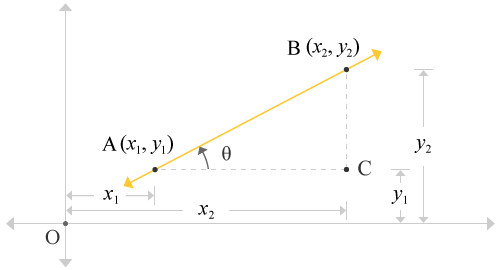Expressing a straight line in standard mathematical form is defined an equation of a straight line in general form. It is also called as standard form of equation of a straight line.
A straight line is usually expressed in graphical system geometrically. It is mostly useful for geometrical analysis. Similarly, the straight lines can also be expressed in mathematical form by developing an equation using the algebraic system but based on the geometrical analysis.
Consider a straight line in a plane and it is assumed to call straight line AB↔.

Assume, the point A is located at (x1, y1) and point B is located at (x2, y2) geometrically. Draw a line from point A towards right side and also draw a line from point B downwards. The line drawn from point A and the line drawn from point B get intersected perpendicularly at a point, which is assumed to call point C. It formed a right angled triangle ΔBAC and assume the angle between hypotenuse and adjacent side is theta (θ) .

Consider a point on the straight line and assume it is called as point D. Let us assume, the coordinates of the point D is (x, y). The point D is a general point which represents each and every point on the straight line including point A and B. Draw a line from D, perpendicular to the line segment CE‾. Thus, it forms a line segment DE‾ and also forms another right angled triangle ΔBDE.

According to above geometrical figure, the line segment DE‾ is parallel to the line segment AC‾ ( DE‾ || AC‾) and the line segment DB‾ is part of the line segment AB‾. Therefore, the angle made by the line segment DB‾ is exactly equal to the angle made by the straight line AB↔ with the horizontal axis. Thence, the angle made by the line segment DB‾ with the horizontal axis is also theta (θ) because triangle ΔBDE and triangle ΔBAC are similar triangles. It means the angle ∠BDE = ∠BAC = θ.
The length of the line segment AC‾ is AC = OC – OA = x2 – x1
The length of the line segment DE‾ is DE = OE – OD = x2 – x
The length of the line segment BE‾ is BE = OB – OE = y2 -y
The length of the line segment BC‾ is BC = OB – OC = y2 – y1
According to the right angled triangle ΔBAC,
tanθ = BCAC
⇒ tanθ = y2 – y1x2 – x1
According to the right angled triangle ΔBDE,
tanθ = BE DE = y2 – yx2 – x
According to above both two trigonometric ratio expressions, the both expressions of trigonometric ratio tangent can be equated because they both are same.
y2 – y1x2 – x1 = y2 – yx2 – x
Apply the principle of cross multiplication and then perform the multiplication.
⇒ (y2 – y1).(x2 – x) = (y2 – y).(x2 – x1)
⇒ y2.x2 – y2.x – y1.x2 + y1.x = y2.x2 – y2.x1 – y.x2 + y.x1
Bring all terms of right hand side to left hand side.
⇒ y2.x2 – y2.x – y1.x2 + y1.x – y2.x2 + y2.x1 + y.x2 – y.x1 = 0
It can be written as follows.
– y2.x + y1.x + y.x2 – y.x1 – y1.x2 + y2.x1 + y2.x2 – y2.x2 = 0
y2.x2 terms are appearing in the expression twice with opposite signs. So, they both get cancelled each other.
– y2.x + y1.x + y.x2 – y.x1 – y1.x2 + y2.x1 = 0
Now, take common x and y from terms for writing the expression in simple and standard form.
(- y2 + y1)x + (x2 – x1)y + (- y1.x2 + y2.x1) = 0
The coefficients of
variables
x and y and remaining part are constants in value. So, we can represent them by some assumed constants.
Assume,
a = -y2 + y1, b = x2 – x1 and c = – y1.x2 + y2.x1
Now, the linear expression can be written in a simple form.
ax + by + c = 0
This linear algebraic form expression represents a straight line in standard form. In this way, the linear equation of a straight line in general form is derived in geometry.
A free math education service for students to learn every math concept easily, for teachers to teach mathematics understandably and for mathematicians to share their maths researching projects.
Copyright © 2012 - 2025 Math Doubts, All Rights Reserved